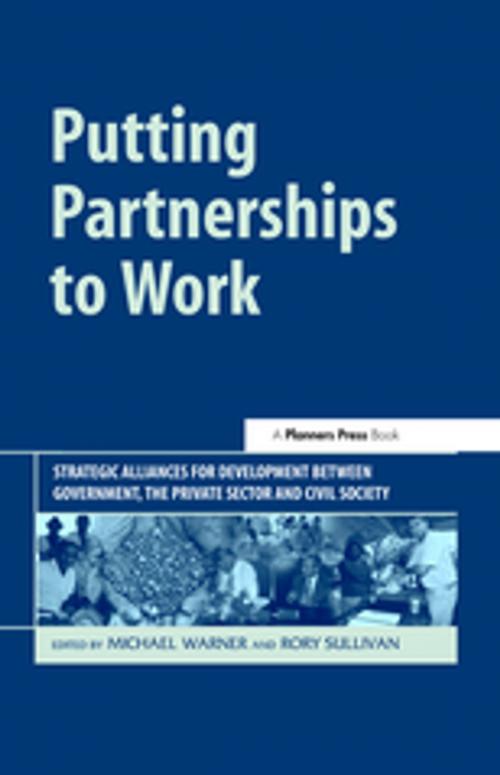Putting Partnerships to Work
Strategic Alliances for Development between Government, the Private Sector and Civil Society
Business & Finance, Economics, Economic Development, Business Reference, Business Ethics| Author: | ISBN: | 9781351281225 | |
| Publisher: | Taylor and Francis | Publication: | October 24, 2017 |
| Imprint: | Routledge | Language: | English |
| Author: | |
| ISBN: | 9781351281225 |
| Publisher: | Taylor and Francis |
| Publication: | October 24, 2017 |
| Imprint: | Routledge |
| Language: | English |
The World Summit on Sustainable Development in Johannesburg clearly identified the corporate sector as one of the key actors in the delivery of national and international poverty reduction targets in developing countries. "Partnerships" between government, civil society and business were proposed as one means whereby these poverty reduction targets were to be achieved. Despite the rhetoric, there was less consideration of how such partnerships could work in practice, the outcomes that could be achieved, or the relative merits of partnerships over other, more traditional approaches to development.
This book is about partnerships between the private sector, government and civil society. Its objective is to share practical experiences in establishing and implementing such partnerships and to show how partnerships work. The focus is on the oil, gas and mining industries, as these sectors have tended to be the primary drivers of foreign investment in developing countries. These corporations increasingly operate in regions characterised by poor communities and fragile environments. The more effective use of external relationships to ensure the effective contribution of these investments to poverty reduction and local environmental management is critical, for the companies, for government, and for the poor.
Putting Partnerships to Work is based on the work of the Secretariat of the Natural Resources Cluster (NRC) of Business Partners for Development (BPD). This major research programme, which ran from 1998 to 2002, aimed to enhance the role of oil, gas and mining corporations in international development. The programme objective was to produce practical guidance, based on the experience of specific natural resource operations around the world, on how partnerships involving companies, government authorities and civil-society organisations can be an effective means of reducing investment risks and of promoting community and regional development. The programme encompassed partnerships in Colombia, Nigeria, India, Venezuela, Bolivia, Zambia, Azerbaijan, Indonesia and Tanzania. The specific projects that were implemented included not only "traditional" development projects such as the provision of water, healthcare or infrastructure but also themes as diverse as conflict prevention, regional development, micro-enterprise development and managing oil spill compensation. Based on the experience of establishing and implementing effective partnerships, the NRC identified good practice, and developed replicable guidelines, tools and training materials.
This book is not only about good practice; it presents both the positive outcomes and lessons from the programme, as well as the risks and costs, and where things went wrong. It also provides evidence not only of the viability of partnerships (i.e. that partnerships "can work") but also evidence that partnership approaches can provide substantially better outcomes for all parties than can more traditional approaches to development or corporate social responsibility. For example, a road in India was constructed at 25% of the cost to government; it took just 11 months for a community health centre in Venezuela to become operational and with its long-term financial future assured; and primary education enrolment rates in the vicinity of a gold mine in Tanzania have jumped from a historic level of 60–80% to almost 100% (as a consequence of improved infrastructure and community awareness of the importance of education). These development and public-sector benefits have been accompanied by substantial business benefits, including significant reductions in the cost of community development initiatives and/or the leverage of additional resources, greater sustainability and viability of development projects and significant improvements to corporate reputation and their local "social licence to operate" with communities. The book argues that to achieve these benefits requires all parties to invest time and effort in first exploring the best design for the partnership, understanding the motivations of their potential partners and, once the partnership has been established, continuing to actively support the partnership and ensure its ongoing viability.
Partnerships that engage the strengths of companies, government and civil society can, under the right conditions, yield better (and more sustainable) results for communities and for business than traditional approaches to development. The authors argue that, because it is built on the central idea of each partner "doing what they do best", the partnership approach offers an opportunity to rethink the way in which companies view they contributions to the livelihoods of local communities. Through partnerships it is possible that community development will be seen less as an "add-on" or "cost" to the company but more an integral part of business strategy providing significant commercial and other benefits.
Perhaps most importantly, partnerships offer the potential for regional operating companies to change the perceptions of government and of civil society that the company will take the primary responsibility for local development. Rather, partnerships enable companies to locate themselves as one of (but not the only) agent of development in the local region. Partnerships enable communities to take charge of their own development needs, interacting with government to jointly design and maintain public services. They also allow government to play its proper role of fulfilling its public mandate, delivering necessary services and ensuring the quality and sustainability of development impacts.
The challenges of poverty reduction in the developing world are so great that no one sector can address them on its own. Partnerships between business, government and civil society are a means of addressing this most fundamental of truths. It is hoped that this book will provide a road map for all those working towards making the elimination of poverty a reality.
The World Summit on Sustainable Development in Johannesburg clearly identified the corporate sector as one of the key actors in the delivery of national and international poverty reduction targets in developing countries. "Partnerships" between government, civil society and business were proposed as one means whereby these poverty reduction targets were to be achieved. Despite the rhetoric, there was less consideration of how such partnerships could work in practice, the outcomes that could be achieved, or the relative merits of partnerships over other, more traditional approaches to development.
This book is about partnerships between the private sector, government and civil society. Its objective is to share practical experiences in establishing and implementing such partnerships and to show how partnerships work. The focus is on the oil, gas and mining industries, as these sectors have tended to be the primary drivers of foreign investment in developing countries. These corporations increasingly operate in regions characterised by poor communities and fragile environments. The more effective use of external relationships to ensure the effective contribution of these investments to poverty reduction and local environmental management is critical, for the companies, for government, and for the poor.
Putting Partnerships to Work is based on the work of the Secretariat of the Natural Resources Cluster (NRC) of Business Partners for Development (BPD). This major research programme, which ran from 1998 to 2002, aimed to enhance the role of oil, gas and mining corporations in international development. The programme objective was to produce practical guidance, based on the experience of specific natural resource operations around the world, on how partnerships involving companies, government authorities and civil-society organisations can be an effective means of reducing investment risks and of promoting community and regional development. The programme encompassed partnerships in Colombia, Nigeria, India, Venezuela, Bolivia, Zambia, Azerbaijan, Indonesia and Tanzania. The specific projects that were implemented included not only "traditional" development projects such as the provision of water, healthcare or infrastructure but also themes as diverse as conflict prevention, regional development, micro-enterprise development and managing oil spill compensation. Based on the experience of establishing and implementing effective partnerships, the NRC identified good practice, and developed replicable guidelines, tools and training materials.
This book is not only about good practice; it presents both the positive outcomes and lessons from the programme, as well as the risks and costs, and where things went wrong. It also provides evidence not only of the viability of partnerships (i.e. that partnerships "can work") but also evidence that partnership approaches can provide substantially better outcomes for all parties than can more traditional approaches to development or corporate social responsibility. For example, a road in India was constructed at 25% of the cost to government; it took just 11 months for a community health centre in Venezuela to become operational and with its long-term financial future assured; and primary education enrolment rates in the vicinity of a gold mine in Tanzania have jumped from a historic level of 60–80% to almost 100% (as a consequence of improved infrastructure and community awareness of the importance of education). These development and public-sector benefits have been accompanied by substantial business benefits, including significant reductions in the cost of community development initiatives and/or the leverage of additional resources, greater sustainability and viability of development projects and significant improvements to corporate reputation and their local "social licence to operate" with communities. The book argues that to achieve these benefits requires all parties to invest time and effort in first exploring the best design for the partnership, understanding the motivations of their potential partners and, once the partnership has been established, continuing to actively support the partnership and ensure its ongoing viability.
Partnerships that engage the strengths of companies, government and civil society can, under the right conditions, yield better (and more sustainable) results for communities and for business than traditional approaches to development. The authors argue that, because it is built on the central idea of each partner "doing what they do best", the partnership approach offers an opportunity to rethink the way in which companies view they contributions to the livelihoods of local communities. Through partnerships it is possible that community development will be seen less as an "add-on" or "cost" to the company but more an integral part of business strategy providing significant commercial and other benefits.
Perhaps most importantly, partnerships offer the potential for regional operating companies to change the perceptions of government and of civil society that the company will take the primary responsibility for local development. Rather, partnerships enable companies to locate themselves as one of (but not the only) agent of development in the local region. Partnerships enable communities to take charge of their own development needs, interacting with government to jointly design and maintain public services. They also allow government to play its proper role of fulfilling its public mandate, delivering necessary services and ensuring the quality and sustainability of development impacts.
The challenges of poverty reduction in the developing world are so great that no one sector can address them on its own. Partnerships between business, government and civil society are a means of addressing this most fundamental of truths. It is hoped that this book will provide a road map for all those working towards making the elimination of poverty a reality.















